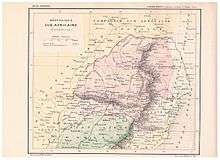Van der Westhuizen
| van der Westhuizen Family |
|---|
van der Westhuizen (also known as van der Westhuisen, van der Westhysen) is a common Afrikaans surname. The largest number of van der Westhuizens can be found in Africa, but because of immigration large numbers of van der Westhuizens can also be found in Argentina, Australia, United Kingdom, Canada, New Zealand and the United States of America. Van der Westhuizens have had a notable influence on every significant phase of South African history, most notably the Great Trek, First Boer War and the Second Boer War, as well as strategic campaigns in both World Wars.
Family history
The origins of the family name began with Pieter Jansz van der Westhuizen, a native of Brugge. The first record of Pieter Jansz's arrival in Cape Town is in 1662 as a soldier for the Dutch East India Company, where he changed his name to van der Westhuizen from Westhuysen. Later Pieter Jansz worked as a servant for Tieleman Hendricks till the late 1660s. Pieter became a Free Citizen ('Vryburger' in Afrikaans) in 1670 along with Hendrik Coester, and in 1673 he married Maria Hendrickz Winkelhuisen, the German widow of Hendrik Barentsz, adopting her three children. Together they had seven children (Maria, Johannes, Claas, Barent, Hendrik, Helena, and Pieter). In 1706 Pieter married Eva Gerritsz Ligthart (widow of Jan Douwensz Mos) from Amsterdam, after the death of Maria earlier that year.
On 23 March 1677, the Cape Council of Policy granted land to Pieter Jansz van der Westhuisen and Willem Schalkszoon van der Merwe in the region of Hout Bay to develop agriculture in the region. Van der Westhuizen founded the largest farm in Hout Bay known as Kronendal, which became a very prosperous piece of farmland in the Cape and even received visits from Simon van der Stel.
The farmlands of Kronendal are the oldest farmlands still in use in South Africa. Maria van der Westhuizen was the daughter of Pieter Jansz van der Westhuizen, and was raised on the family farm of Kronendal. Maria received much fame for her wealth, real-estate and was the founding ancestor of both the Van Niekerk and the Walters families. Maria left her fortune to her seven sons, which consisted of 83000 guilders, 35 slaves, 1400 sheep, 25000 vines and 10 farming estates (Mosselbank, Brakkefontein, Sandvliet, Slot van Paarl, Meerendal, De Grendel, Hoorenbos (8900 guilders), De Tijgerberge (21600 guilders), Drooge Vallei (15000 guilders) en Zeekoeivallei (1209 guilders)). Because of the inheritance left from Maria to her seven sons who each received about 12000 guilders, they were able to have a significant influence on the economy of the Cape after Maria's death in 1734.
Family tributes

The well known van der Westhuizen street in the Cape is named after the van der Westhuizen family (Other significant streetnames also exist in the Northern Cape, Western Cape, Gauteng ('Transvaal'), Chatham in the United Kingdom and in Alberta Canada).
Notable family members
- Joost van der Westhuizen, former South African rugby union footballer
- Johann van der Westhuizen, judge in the Constitutional Court of South Africa
- Jacob van der Westhuizen, Director of the Institute for Criminology of UNISA,
- Louis van der Westhuizen, a Namibian cricketer
- Charlize van der Westhuizen, a South African cricketer
- Yolandi van der Westhuizen, an international cricketer
- Hermanus Petrus van der Westhuizen, a South African Leather Designer
- Minki van der Westhuizen, well-known model
- Ian Isak van der Westhuizen, well-known actor
Boers exiled during Anglo-Boer War
- Jacob Willem van der Westhuizen
- Frederik Korsten van der Westhuizen
- Cornelius van der Westhuizen
- Hermanus Johannes van der Westhuizen
- Lourens Martinus van der Westhuizen (Korporaal)
- Cornelius van der Westhuizen
- Hermanus Daniel van der Westhuizen
- Nicholas van der Westhuizen
- Hermanus Petrus van der Westhuizen
- Jan Johannes Matthys van der Westhuizen
- Nicholas Johannes van der Westhuizen
- Andrew Baird van der Westhuizen